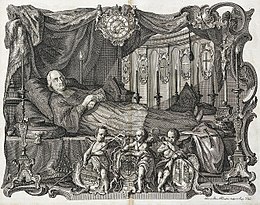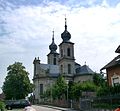Damian Hugo Philipp von Schönborn-Buchheim

Damian Hugo Philipp Reichsgraf von Schönborn-Buchheim (born September 19, 1676 in Mainz ; † August 19, 1743 in Bruchsal ) was Prince-Bishop of Speyer from 1719 , Cardinal from 1721 and Prince-Bishop of Konstanz from 1740 .
Origin - The Schönborn House
Damian Hugo Philipp von Schönborn-Buchheim came from the von Schönborn family . He was the third son of 18 children of kurmainzischen State Minister Melchior Friedrich von Schönborn-Buchheim was born and had the Mainz elector-archbishop Lothar Franz von Schönborn as uncle.
His brothers were the Prince-Bishops Franz Georg von Schönborn-Buchheim , Friedrich Karl von Schönborn-Buchheim and Johann Philipp Franz von Schönborn and the politician Rudolf Franz Erwein von Schönborn ; his great-nephew and godchild was the Speyer cathedral capitular and later Bishop of Roermond , Philipp Damian von Hoensbroech (1724-1793).
Life
Spiritual career
Although he received a deeply religious education, he was not initially chosen for the clergy. After studying at the universities of Würzburg , Mainz , Rome , Leiden and Leuven , he was a company commander in the army of Emperor Leopold I in 1699. From 1699 to 1706 he also served as Commander of the Teutonic Order of St. Aegidius in Aachen and from 1707 to 1715 as Land Commander of the Ballei Hessen of the Teutonic Order in Alden-Biesen and Marburg as well as envoy at the Viennese court and undertook diplomatic missions.
At the suggestion of the Polish electoral king August the Strong , he was in 1715 by Pope Clement XI. called to the college of cardinals although he had not yet received ordinations. In 1721 he was cardinal deacon of the titular deaconry San Nicola in Carcere . Despite his participation in two conclaves Hugo Damian remained in the curia without influence. In 1719, through the mediation of his uncle Lothar Franz, he was elected Prince-Bishop of Speyer. Only then was he ordained a priest on August 15, 1720 . He was ordained bishop on February 24, 1721 by Johann Edmund Gedult von Jungsfeld , auxiliary bishop in Mainz ; Co-consecrators were Johann Baptist Gegg , auxiliary bishop in Worms, and Johann Joachim Hahn , also auxiliary bishop in Mainz. Cardinal von Schönborn took part in the conclave of 1721 , which Pope Innocent XIII. chose; he appeared in Rome the day before the end of the conclave.
Bishop of Speyer
His more than twenty years as Bishop of Speyer was a peaceful epoch combined with an economic and cultural boom. Damian Hugo Philipp tried to consolidate the financial budget, to this end he carried out various administrative reforms and founded model companies to stimulate the economy. In 1722 compulsory schooling was introduced.
After heated arguments with the council of the Protestant imperial city of Speyer , he moved his residence to Bruchsal in 1723 , where he had the magnificent Bruchsal Castle built by the ingenious master builder Balthasar Neumann . In Waghäusel he left off in 1724 by Johann Michael Ludwig Rohrer the Hermitage hunting lodge built that by 1737 Neumann was expanded. At the 1724 conclave , which Pope Benedict XIII. chose, he was not present.
In 1730 Cardinal Schönborn took part in the four-month conclave in Rome, in which Clement XII. was elected Pope.
Late years
With the help of his brothers, he was elected coadjutor of the Diocese of Constance as early as 1722 , but only acquired ownership of the bishopric 18 years later and was no longer able to exercise any influence there. He could no longer take part in the 1740 conclave . Hugo Damian von Schönborn died of the effects of malaria that he contracted during his time in Rome. After a temporary burial, he was buried in 1755 in the bishop's crypt in the Peterskirche in Bruchsal , which was newly built on his instructions . Despite major construction activities, he left his successor 1.8 million guilders in the state treasury.
During his life and reign the high point of the Schönborn family's influence on the fate of the empire fell.
coat of arms
Prince Bishops usually introduced gemehrtes personal crest, which consists of elements of the family crest and the arms of the diocese.
The splendid coat of arms of Damian Hugo Philipp von Schönborn-Buchheim on the facade of the Bruchsal Castle that he built contains the following three coats of arms: The (optically) left coat of arms is square . In alternation there is a silver cross in blue (for the bishopric of Speyer ) and in red a silver castle with a gate and two towers, above a gold crown (for the prince-provost of Weißenburg ). This crossing indicates the long-term personal union of the two offices. The right shield shows the family coat of arms of the Schönborn : in red a two-tailed golden lion striding on three silver tips, which is crowned in blue. In the middle there is a smaller coat of arms with a double black paw cross in silver, which stands for the two Land Commanderies of the Teutonic Order Alden-Biesen and Marburg (see also the list of those coming of the Teutonic Order ). The three individual coats of arms are arranged under a princely hat . Decorated with further insignia of power, the coat of arms is framed by a gold frame that ends with a cardinal's hat . There are no references to the Diocese of Constance in this representation because Damian Hugo only took it over much later.
Varia
The Schönborn-Gymnasium Bruchsal , which he donated in 1723 and founded in 1755 , which was originally located in Bruchsal Castle, was named after him in 1954.
The Heidelberg medical professor Johannes Christoph Ludwig Beringer (1709–1746) acted as his personal physician .
Buildings of the Prince-Bishop Damian Hugo
Bruchsal Castle , built from 1720
Kislau Hunting Lodge , built in 1721
Hermitage (Waghäusel) , built from 1724
New Castle (Meersburg) , completed from 1740
St. Peter zu Bruchsal (from 1736)
literature
- Constantin von Wurzbach : Schönborn, Damian Hugo Graf . In: Biographisches Lexikon des Kaiserthums Oesterreich . 31st part. Imperial and Royal Court and State Printing House, Vienna 1876, p. 134 ( digital copy ).
- Anton Wetterer: The religious-ascetic life of Cardinal Damian Hugo von Schönborn, Prince-Bishop of Speier (1719–1743) and Constance (1740–1743). In: Freiburg Diocesan Archive, Volume 43 , 1915, SS 151–166.
- Ludwig Stamer: Damian Hugo Philipp Graf von Schönborn. In: New German Biography (NDB). Volume 3, Duncker & Humblot, Berlin 1957, ISBN 3-428-00184-2 , p. 500 ( digitized version ).
- Christof Dahm: Schönborn, Damian Hugo Philipp Reichsfreiherr (Reichsgraf since 1701) von. In: Biographisch-Bibliographisches Kirchenlexikon (BBKL). Volume 9, Bautz, Herzberg 1995, ISBN 3-88309-058-1 , Sp. 620-623.
- Hans Ammerich : The diocese of Speyer and its history. Volume 3: From the Reformation to the end of the old diocese. Kehl am Rhein 1999, ISBN 3-927095-49-4 , pp. 24-26.
- Stephan Mauelshagen: Order knight - sovereign - church prince. Damian Hugo von Schönborn (1676–1743) - A life in the old empire. Ubstadt-Weiher 2001, ISBN 3-89735-173-0 .
- Andreas Flurschütz da Cruz: Between Empire and Revolt. The Habsburg ambassadors in Hamburg at the beginning of the 18th century. In: Journal of the Association for Hamburg History 99 (2013), pp. 1–29.
Web links
- Schönborn, Damian Hugo Philipp von. In: Salvador Miranda : The Cardinals of the Holy Roman Church. ( Florida International University website), accessed August 8, 2016.
- Entry on Damian Hugo Philipp von Schönborn Bushein (sic!) On catholic-hierarchy.org ; accessed on August 8, 2016.
- Description of the Bruchsal Castle and the coat of arms there by Bernhard Peter
- Damian Hugo Philipp von Schönborn-Buchheim as the non-present Landkomtur of the Ballei Hessen from Bernhard Peter
- Former hunting lodge Kislau
- Zeilitzheim Castle (temporarily residence of Damian Hugo Philipp)
Individual evidence
- ↑ Source on participation in the conclave of 1730 in the Google book search
| personal data | |
|---|---|
| SURNAME | Schönborn-Buchheim, Damian Hugo Philipp von |
| ALTERNATIVE NAMES | Schönborn-Buchheim, Damian Hugo Philipp Reichsgraf von |
| BRIEF DESCRIPTION | Cardinal and Prince-Bishop of Speyer and Constance |
| DATE OF BIRTH | September 19, 1676 |
| PLACE OF BIRTH | Mainz |
| DATE OF DEATH | August 19, 1743 |
| Place of death | Bruchsal |









